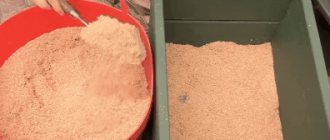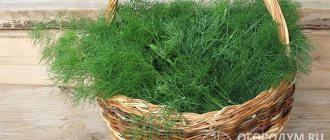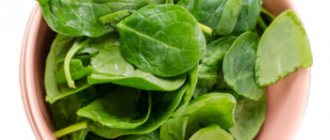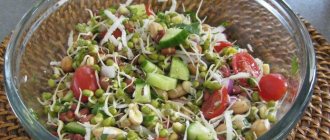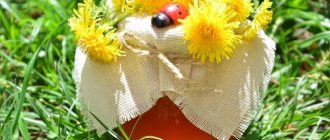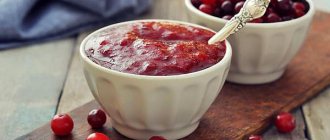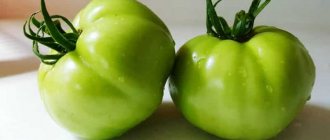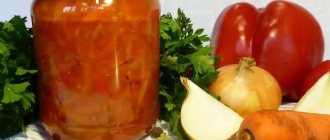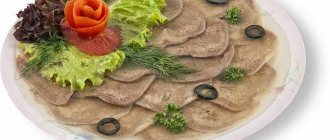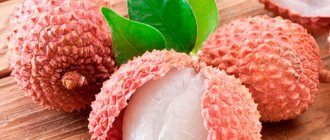Sea buckthorn with sugar without cooking
Even sea buckthorn prepared without sugar will last well all winter.
From such a preparation you can cook compotes, make sauces or syrups. You will need 1 kg of sea buckthorn berries and 700 ml of water.
Preparation. Wash the berries, dry and mash a little using a wooden potato press. Pour water over the berry mass, stir, strain through cheesecloth and squeeze the juice out of the berries. Then pour into clean bottles, sterilize, seal and store in a cool, dark place.
Due to the fact that the berries do not undergo heat treatment, they do not lose their beneficial properties.
You will need 1 kg of sea buckthorn berries and 1-1.5 kg of sugar.
Preparation. Rinse the berries thoroughly and dry. Place in an enamel pan, add sugar and mash well with a wooden potato masher. Transfer the resulting mass into prepared jars and close the lids. Store this preparation in a cool, dark place.
This method of harvesting sea buckthorn for the winter allows you to preserve almost all the beneficial properties of this berry.
You will need 1 kg of sea buckthorn berries and 1 kg of natural honey.
Preparation. Rinse the berries and dry well. Using a blender, mix them with honey until smooth. Place the resulting berry mass into sterilized jars, close the lids and store in a cool, dark place.
Video on how to make delicious sea buckthorn jam
You can make your favorite jam from more than just one berry. It tastes best with the addition of walnuts. And the syrup is prepared on the basis of rose hips.
That's so interesting! That is, there is no longer one complex of vitamins, but two, and even three. After all, rose hips are known as a storehouse of vitamin C, and not only... And nuts also contain quite a few useful things.
This is a super vitamin jam. Be sure to cook it, it’s delicious.
Friends, today these are all the ways I know of preparing delicious berries. There are, of course, options and variations, but they are all made based on these basic principles and recipes.
Therefore, if you know them, you will be able to prepare absolutely any jam, either with or without cooking.
In general, have you noticed how easy it is to prepare sea buckthorn for the winter? And what delicious “magic” is obtained in each prepared jar! And all this is not only tasty, but also very healthy!
Therefore, cook, eat with pleasure, and always be healthy!
Sea buckthorn is a luxurious tree, from branches to fruits filled with microelements and vitamins. It has been used as a medicinal plant since ancient times.
Particularly valuable are the golden fruits that appear on the tree in the autumn. They are classified as multivitamins. In addition to vitamins, fruits contain a lot of sugar, acids, macro- and microelements, oils, and plant antibiotics. How can one not take advantage of such wealth?
If sea buckthorn is stored correctly, all the beneficial substances will remain with it. The medicinal qualities of the plant can be used at any time, not just in the fall.
How to harvest
In order to store sea buckthorn for a long time, you should decide before harvesting how to use it.
If the fruits are intended for fresh consumption, for making compote or jam, they are removed in September, in the early days, when they have not yet reached full ripeness. At this time, the berry contains vitamin C in large quantities. And the skin and structure are still quite dense, which will prevent the fruits from being damaged during the cooking process.
To make marmalade, jam, or sea buckthorn honey, the fruits do not necessarily need to be selected whole. But they must be ripe and juicy. They will not reach this level of maturity until November.
- Harvesting should not occur during rain. Moisture negatively affects the quality of the berries and quickly makes them unusable. For the same reason, before storing fresh sea buckthorn, it is not washed.
- You must first collect the fruits located on the upper branches, moving from top to bottom.
- To collect sea buckthorn, you should prepare several boxes in advance and cover their bottoms with paper. And when the harvest is harvested, it is sent to a cool place (cellar or refrigerator).
Fresh sea buckthorn can also be stored in bags made of thick polyethylene. In this case, the berries will remain fresh for up to 1 month. Therefore, it would be more correct to process them in such a way as to preserve the beneficial properties of the product as much as possible.
We suggest you read: How to remove a pen from wallpaper - 11 proven methods
Storage methods and conditions
Before poisoning gooseberries for storage, you need to rinse the berries under water and dry them thoroughly. Any debris contributes to the development of rotting. Berries with thick skins are suitable for long-term storage, and those with soft skins are suitable for freezing or making purees.
When choosing a container, it is necessary to take into account that after opening the gooseberries should be eaten immediately. Therefore, it is recommended to make portioned preparations. Small plastic containers or bags are suitable for this. If the latter option is chosen, then the gooseberries must be prepared for long-term storage. First you need to put the berries on a tray and let them sit for several hours, and then put them in the freezer. After this, the fruits can be packaged in bags.
At room temperature
Ripe gooseberries can be stored at room temperature. Under such conditions, the berries retain their original freshness for five days. To increase the length of the storage period, it is recommended to lay unripe fruits or place the gooseberries in a cooler place. In both cases, the berries will remain fresh for ten days. In this case, the fruits must be placed in a container with a volume of up to five liters.
Freezing
This option is considered the most common, as it allows you to preserve the freshness of the berries and beneficial microelements during the winter. Before freezing, the berries need to be sorted, removing overripe ones, washed and placed in a container. Then the container can be sent to the freezer.
Making puree
It is more convenient to freeze puree in the refrigerator. In addition, gooseberries in this form are immediately ready to eat. To prepare the puree you will need:
- Take ripe fruits with thin skin, sort and rinse under water.
- Beat with a blender until mushy.
- Mix the resulting mass with sugar in a ratio of 1 kilogram per 350 grams.
- Stir again and leave for an hour.
After the specified period has expired, the puree should be distributed into containers and placed in the freezer.
In sugar
To store gooseberries in sugar you will need:
- Rinse the berries and dry them on a towel.
- Place the fruits in a saucepan and add sugar in a ratio of 1 kilogram per 400 grams.
- Mix all ingredients and place into containers.
It is recommended to take containers with a tight lid, which will prevent microorganisms from entering the container from the outside. After this, the container can be placed in the freezer.
We recommend: How long can meat be stored in the refrigerator: folk and generally accepted methods
In syrup
It is recommended to store overripe berries in the form of syrup. In this case you need:
- Wash and dry the gooseberries.
- Mix water and sugar and prepare syrup.
- Pour the syrup over the fruits previously placed in containers.
Containers must be filled to the brim. After this, the containers are sent to the freezer.
Whole berries without sugar
To preserve whole berries, you will need to cover a tray with cling paper and place the gooseberries on top. After drying, the fruits should be placed in the freezer for several hours. Then the berries are transferred to bags.
Drying
To dry ripe gooseberries, you need:
- Wash and remove stems from the berries.
- Place over a steam bath.
- Arrange the fruits on a baking sheet.
- Place the baking sheet in an oven preheated to 30 degrees. After 10 minutes, the temperature should be increased to 70 degrees.
During the drying process, the oven must be periodically opened and the fruits must be stirred. The procedure takes seven hours. At the end of the process, dried gooseberries should be placed in a fabric or paper bag. In this form, the berries are suitable for consumption for two years.
In a refrigerator
In the refrigerator, the fruits remain fresh for two weeks. In this case, it is recommended to put the gooseberries in a container, covering the top with paper. The optimal storage temperature is +5 degrees.
Conservation
The large amount of acids contained in sea buckthorn allows the berries to be preserved for a long time. If they are planned to be mixed with sugar, the fruits are sorted, washed, dried, crushed, placed in well-pasteurized jars, filled with sugar syrup and covered with scalded lids. Prepare at home:
- compotes;
- juices;
- jam;
- jam.
Preservation made by this method is well stored in a cool room for 3 to 4 months. In winter, the jars can be taken out onto the balcony.
The preparations can be stored longer. To do this, berries in already sealed containers are subjected to heat treatment in a water bath. Store them in a cool and dark place.
The prepared jam is placed in pasteurized glass jars, hermetically sealed, the container is turned upside down and left for 2 weeks. If the lid swells, the product is considered spoiled. You can store jam indoors, but not in too warm conditions in a dark place. The optimal temperature is +15°C. Taste qualities will be preserved until the new harvest. Compotes and juice are kept at normal room temperature.
Jams, jams and marmalade made from sea buckthorn spoil less often. More often foam forms on them. In this case, it is removed, the contents of the jar are transferred to a saucepan, sugar is added (100 g for each kg of product), boiled again and used for tea in the near future. If containers with cracks are found, they are thrown away along with the contents.
We recommend: How to preserve peeled potatoes
Storing dried sea buckthorn
The shelf life of fresh sea buckthorn is up to 1 month. It retains vitamin C along with other beneficial substances. But its storage temperature cannot be higher than 3°C.
It is possible to store sea buckthorn directly in clusters in the fruit compartment, which is found in any refrigerator. But you can also carefully remove the fruits from the branches, place them in a container made of opaque glass or ceramics and cover with a lid.
The fruits fully ripen and acquire a rich yellow-orange color by the end of summer. The harvest begins from this time and continues until frost.
The fruits fully ripen and acquire a rich yellow-orange color by the end of summer.
Sea buckthorn has many thorns, so work is carried out with protective gloves.
They start collecting from the top branches and do it in different ways:
- Berry branches are cut from the tree and placed in the freezer, after which the fruits are easily separated from the stalks. This way you can harvest a significant amount of crop in a minimum time, but damage is caused to the trees.
- After the first frost, polyethylene or dense material is laid out under the trees, the branches are struck several times, the berries fall off and they are carefully collected.
- Use a loop-shaped device made of sharpened wire. A loop attached to a long handle moves along the branches and cuts off the berries that fall onto the material laid in advance.
- Cut with nail scissors or tongs.
Before long-term storage in any form, berries undergo mandatory pre-treatment:
- separate garbage and rot;
- wash them in a container with a sufficient amount of cool water;
- remove excess moisture by air drying in a dark place or with a towel.
Crops harvested in dry weather are less likely to spoil and are suitable for fresh storage. Berry branches are cut from the tree, hung on a rope or laid out in one layer on paper.
The branches are laid out, periodically rearranged so as not to spoil, and rot is removed.
Crops harvested in dry weather are less likely to spoil
Store the product in a room with sufficient air circulation, from 0 to 4 C: in this case, all beneficial properties are preserved, the product is usable for several months.
Soaked sea buckthorn
Freshly picked fruits with the peel intact are soaked. They are placed in clean jars, filled with cooled boiled water, and covered with a plastic lid. Take it to a dark place with a temperature of up to 4 0C.
Freshly squeezed juice is heated to a temperature of 70 0C. Add and dissolve sugar. Bring the mixture to a boil and cook over low heat for at least half an hour, approximately 2/3 of the initial mass should remain.
The jelly is poured into jars, sterilized for 15 minutes, and sealed. Keep in a cool place. For 1 liter you need to take 600-800 g of sugar.
Preparing a variety of jams, purees, and juices from berries with sugar is a traditional way of storing sea buckthorn. Preservation allows you to preserve a significant amount of beneficial properties.
Harvests harvested before frost with a durable shell are suitable for drying.
Before heat treatment, it is advisable to dry the sea buckthorn in the air, in the shade, under a layer of gauze. Then spread in one layer on a dryer or oven rack.
Drying is carried out in three stages:
- The first 2 hours are heated to 35... 40 0C.
- The temperature is raised to 60... 80 0C, and the formation of condensate is constantly monitored.
- Bring to 40 0C, make sure that the berries do not burn.
We suggest you read: How to wash a bra with wires in the washing machine
The degree of drying is assessed by appearance: the finished berries are elastic, light brown in color. Keep them in a wooden box or cotton bag in a well-ventilated area.
- separate garbage, rot,
- wash them in a container with enough cool water,
- remove excess moisture by air drying in a dark place or with a towel.
Soaked sea buckthorn
Is it possible to store sea buckthorn on a branch?
To prevent sea buckthorn from becoming sour when harvested, you can pick a twig with the berries stuck to it. For whole fruits, the fresh shelf life is significantly increased.
Conditions for lying down
Branches with sea buckthorn should be kept in a dry, cool place. A basement or refrigerator is suitable for this. The berries can also be separated from the branches, placed in a closed container, which is then placed in a cold room. The fruits are separated carefully, otherwise the likelihood of them rotting increases.
See also
Diagram and how to properly prune blueberries for beginners
Read
Shelf life of fresh product
At a storage temperature of +3...+4 °C, sea buckthorn does not spoil for 4-5 weeks. It is constantly inspected, since even one spoiled berry can infect all the others with rot. If the fruits are placed in a plastic bag and the air is pumped out of it, the shelf life will increase significantly. Without oxygen, the respiration of berries slows down.
Sea buckthorn jam
Sea buckthorn jam has an interesting taste, unusual aroma and attractive bright color.
You will need 1 kg of sea buckthorn berries and 1 kg of sugar (although the amount can be varied).
Preparation. Wash the berries, dry them, add sugar and leave for 2-3 hours until they produce juice. Then place the pan with the berries over low heat, bring to a boil and cook for 15 minutes, skimming off any foam. Check the readiness of the jam by dropping a drop onto the saucer. Cook more if necessary. Cool the finished jam, place it in prepared jars and cover with plastic lids. Store in a cool, dark place.
Freezing
The fruits of the sea buckthorn tree tolerate freezing well and retain their healing properties for a long time (almost up to 1 year). In this case, you must adhere to the following steps:
- The berries are sorted, removing unripe, crushed, and spoiled ones.
- Sea buckthorn is washed in a spacious container with water. This procedure will help preserve the integrity of the fruit, as opposed to washing under a running stream.
- The berries are dried on napkins or towels, then placed in one layer on boards, covered with film and placed in the freezer (-17°C -12°C) for 24 hours.
- Frozen berries are poured into a food container, closed tightly and kept in the freezer.
- Sea buckthorn can be stored in the freezer for about one year.
Freezing fruits is possible only once. If you do this again, the berry will lose most of its vitamins and other nutrients.
Picking berries and preparing for storage
When it is not possible to preserve berries frozen or canned, they can be dried. This preparation will retain its healing qualities in full and is suitable for making drinks and desserts.
You need to dry the berries in a certain sequence:
- The fruits are sorted, washed and dried at room temperature.
- Make a soda solution (1 teaspoon per 1 liter of water) and heat it almost to boiling.
- The fruits are immersed in a hot solution for 3 - 4 seconds and immediately washed in clean water.
- Lightly dried berries are placed on a baking sheet in one layer and covered with mesh or parchment. It will take time for them to dry completely. Drying sea buckthorn can take up to 1 month in hot, dry weather conditions.
You can also dry sea buckthorn in the oven. To do this, you will first need a low temperature (35°C - 40°C) and 2 - 3 hours of time. Then the temperature is increased to 60°C, and the fruits are kept in such conditions with the oven door open until completely dry.
Dried berries are kept in natural conditions for another 1 - 2 days, after which they are placed in paper bags or glass containers.
Dried sea buckthorn should be stored at temperatures up to 18°C.
Sea buckthorn jelly
Sea buckthorn contains almost no gelling substances, so when preparing jelly it is necessary to add pectin.
We invite you to read about Ingrown toenail: how to treat it at home?
You will need 1 kg of sea buckthorn berries, 600 g of sugar and 10 g of pectin.
Preparation. Wash the berries, place them in a deep saucepan and cook a little until they soften and burst. Then mash the berries using a wooden potato masher directly in the pan. Rub the resulting mass through a sieve - a kilogram of berries should yield approximately 800 ml of thick juice.
Where and how to store sea buckthorn oil and candles
Soaked sea buckthorn
Storing sea buckthorn oil is most effective in the refrigerator, in an opaque glass container. In a transparent container, the product loses quality. The beneficial substances are destroyed, and its taste becomes bitter.
If the oil is made at home, it will keep on the refrigerator shelf for 1 year.
The shelf life of sea buckthorn oil purchased at a pharmacy is 2 years from the date of manufacture. It also needs to be stored refrigerated, in a dark glass bottle.
Storage of sea buckthorn oil in capsules should also occur at low temperatures in a dark and dry place. Its shelf life is 2 years from the date of issue.
The place where you can store sea buckthorn candles for a long time (up to 2 years) is a cool cellar, basement, refrigerator. It is important that the temperature does not rise above 15°C.
Sea buckthorn is a unique plant that is used in medicine, cosmetology, and cooking. Berries that have not been subjected to prolonged digestion are considered the most useful, since exposure to high temperatures destroys the beneficial properties of the fruit. Now you know how to store sea buckthorn in winter, and if you have any questions, be sure to leave them in the comments.
Soaked sea buckthorn
How to prepare grape leaves for dolma for the winter
Grape leaves have long been popular in oriental cuisine, due to their specific pleasant taste and beneficial properties. It has been proven that the consumption of such an ingredient relieves pain from varicose veins, relieves swelling, stimulates blood circulation, and enriches the body with valuable vitamins and microelements.
It is important that during long-term storage the product retains the maximum amount of useful substances in its composition, therefore, of the existing methods, many housewives prefer freezing.
Interesting: You can pickle saffron milk caps in a plastic bucket
For these purposes, it is better to choose young specimens of medium size with small veins. It is better to choose the 5th–7th leaf from the top of the vine.
The following foliage is considered unsuitable for cooking:
- from wild (maiden and ornamental) grapes;
- affected by sunburn, mold, fungi and pests;
- with a suspicious yellowish, whitish or cream color;
- old (dangerous due to components harmful to human health);
- growing on a vine near busy roads and industrial production.
Did you know? Dolma has become the source of international controversy: the Azerbaijan National Culinary Center has accused Armenia of “appropriating” the dish, and recently the UNESCO Intergovernmental Committee recognized the traditions of its preparation in Azerbaijan as one of the elements of the intangible cultural heritage of humanity.
Before freezing, it is advisable to prepare the necessary containers. Remember that thin polyethylene and cling film are subject to crumbling under prolonged conditions of low temperatures. In this regard, dense bags are preferred.
Preparing the leaves
To properly freeze grape leaves, you need:
- cut off the ponytails completely;
- thoroughly rinse the workpiece on both sides;
- dry.
Packaging
Dry leaves are stacked on top of each other in 10 pieces and rolled into a roll. In this form, it is packed into bags and sent to the freezer. It is important that there is as little air as possible inside the package. This will protect the product from foreign odors, allow it to cool faster and be better preserved.
Did you know? Dolma was a dish of the court cuisine of the Ottoman Empire.
For proper harvesting, you need to know when to collect and where best to get grape leaves. For dolma, it is preferable to use white grape varieties. Their plate does not have such a jagged edge as the red varieties, and therefore it is easier to wrap minced meat in it. The foliage is collected when the bush is flowering, in late spring or early summer.
Tender leaf blades five through seven are best, if you start counting from the top of the vine. The average size roughly corresponds to the size of the palm: this will be the most convenient way to wrap the filling.
Leaves are cut off before spraying grapes with chemicals. During the summer, you can also carry out pruning, making sure that after treating the plant with fungicides and insecticides, the period specified in the instructions for the drug passes.
Important! Do not eat products from bushes located along highways!
As with any preparation, the quality of the raw materials plays a crucial role, so it is important to understand which leaves can be used for cooking. They should be a uniform green color, without yellowing, spots or signs of pest damage.
There are several ways to prepare food for the winter, the simplest of which is freezing. But the pickled shell has an additional original flavor. Let's consider all possible ways of harvesting grape leaves.
Freezing
Prepared leaves for freezing must be completely dry. Then they do this:
- Place 10–15 leaves and roll them into a tight roll.
- The roll is wrapped in cling film.
- The rolls are placed in a plastic box, since the product will be fragile after freezing.
To prepare dolma, the pieces will need to be defrosted at room temperature or doused with boiling water.
Important! The number of leaves in one roll should correspond to the amount of dolma that is usually prepared at a time.
Bottled storage
This is an original way to keep leaves fresh for a long time. For it you need to prepare empty plastic bottles. The further procedure is as follows:
- Pour a teaspoon of salt and soda into each bottle, add a little water and shake thoroughly so that the mixture covers the entire inner surface. Then the bottle is rinsed with clean water and dried.
- Small stacks of leaves (3–5 pieces) are rolled into tubes and placed very tightly in the bottle, carefully tamping them down with a stick. The bottle must be completely filled. Sometimes a little salt is added at this stage.
- The bottle is pressed down to release all the air and securely closed with a lid.
This container is stored in a dark, cool place for up to 2 years. To prepare, you need to cut the bottle, remove the leaves and fill with cold water. Sometimes a yellowish coating may appear on the surface, which is not a sign of spoilage.
Did you know? In some regions, fig and quince leaves are used to prepare dolma.
Canning
For preservation, it is necessary to properly prepare glass jars and lids. Sterilization of dishes can be done in a pan of boiling water, in a double boiler or slow cooker, in a microwave or oven. Each jar should be treated with hot steam for 20–25 minutes. With this method, the cuttings do not need to be cut; it will be convenient to use them to pull the workpiece out of the jar. Proceed with the prepared leaves as follows:
- The leaves are rolled into a tube and placed tightly in jars, which are then filled with boiling water for 10 minutes. Afterwards, drain the water and fill the jar with boiling water again.
- Add 1 tbsp per liter of water. l. salt and sugar. Bring the mixture to a boil, stirring to dissolve the salt and sugar.
- The water from the cans is drained and filled with a boiling solution.
- The jar is rolled up and gradually cooled.
Interesting: How to Make Horseradish at Home for the Winter Recipe for the Winter
This product should be stored in a cool and dark place.
Pickling
Containers for pickling are processed in the same way as for canning. Then do this:
- Place 4-5 peppercorns, 1-2 buds of dried cloves, 1-2 bay leaves at the bottom of the jar.
- Rolled leaves are placed tightly on top of the spices and filled with the same solution as for preservation, with the addition of 2 tbsp. l. 9% vinegar.
- The jar is closed and stored in a cool place for up to three months, and dolma can be prepared from such a preparation in just a few days.
Pickling
Salting consists of placing the product in a solution of table salt. To pickle grape leaves, do this:
- The rolled rolls are placed tightly in a clean container and poured with boiling water. After 10 minutes, the water is drained.
- The saline solution is prepared based on the proportion: 20 g of salt per 1 liter of water. Add the required amount of salt to the drained water, bring the solution to a boil and pour it into the jar.
- Cover the container tightly, cool and store in the refrigerator.
Dry storage
For this method, brine filling is not used, but the container must be sterilized beforehand. The sequence of further preparation of the workpiece is as follows:
- Place 10–12 leaves at the bottom of the jar, press down and lightly sprinkle with salt.
- The next layer is compacted tightly and salted again.
- The filled jar is sterilized for 10–15 minutes in the oven or steamed, and then closed with a lid using a special key.
Grape leaves are an integral part of dolma. And although this oriental dish is in many ways reminiscent of cabbage rolls, traditional for Slavic cuisine, they cannot be replaced with white cabbage. In order to enjoy the spicy taste of the dish all year round, you should prepare the future “wrapper” for the rice and meat filling in advance for the winter. Is it possible to freeze it, and how to do it correctly, find out further from the article.
Grape leaves have long been popular in oriental cuisine, due to their specific pleasant taste and beneficial properties. It has been proven that the consumption of such an ingredient relieves pain from varicose veins, relieves swelling, stimulates blood circulation, and enriches the body with valuable vitamins and microelements.
For these purposes, it is better to choose young specimens of medium size with small veins. It is better to choose the 5th–7th leaf from the top of the vine. This wrapper is easy to work with, which is not the case with wrappers that are too small or too large. Leaves should be picked between late spring and mid-June, when they reach their peak growth. Healthy, well-developed specimens of regular shape without damage or signs of disease are preferred.
Oriental dishes have long been part of our lives. For example, dolma, beloved by many. It is very similar to our cabbage rolls. Only for its preparation they use grape leaves instead of cabbage leaves. Fans of this unusual dish for our area may be interested in how to store grape leaves for dolma so that it can be prepared even in winter.
Let's take a closer look at each of them.
The easiest way to store grape leaves for dolma is to sterilize them and roll them into jars.
- In order for them to retain their qualities for a long time, they are collected in 10-15 pieces and rolled into a tight roll.
- Then, the leaves folded in this way are placed in a glass jar and sterilized for 20 - 25 minutes, having previously closed the lid tightly.
- After the jars have cooled, they are rolled up and placed in a dark and dry place.
- The optimal period for collecting grape leaves is the time when the vine begins to flower.
- It is recommended to use leaves of white grape varieties for preservation, since they differ favorably from others in their sweet and sour taste, which will positively affect the taste properties of dolma, giving the dish a wonderful piquancy. If you decide to use red grape leaves for harvesting for the winter, remember that their disadvantage is their uneven surface and hardness.
- Only young leaves are suitable for dolma, and it is important to cut them from the vine, which is located as far as possible from the roadway.
- Never use damaged or torn grape leaves for preservation. Take only smooth, whole leaves, preferably the same size.
- Cooking time: approximately 35-50 minutes.
- Number of blanks: 3 blanks of 20 leaves.
Interesting: If pike has been in the freezer for a year, you can eat it
Sea buckthorn syrup
You can make cocktails from sea buckthorn syrup, add it to desserts, use it as a marinade or in sauces.
You will need 1 kg of sea buckthorn berries and 600-700 g of sugar.
Preparation. Rinse the berries and dry well on a towel. Then mash them using a wooden press or beat them in a food processor and squeeze the juice through cheesecloth. Pour it into a saucepan and add sugar at a ratio of 1:1. Heat the juice over low heat, stirring until the sugar dissolves, but do not bring to a boil. Pour the hot syrup into sterilized jars, cool and close the lids. Store the syrup in the refrigerator.
Freezing sea buckthorn
For this method, dry berries are used. They are placed in small portions (one-time use) in bags or containers and sent for rapid freezing.
Work begins as soon as the berries are picked, while protecting them from sunlight. Compotes, fruit drinks, and jam are made from frozen and fresh sea buckthorn.
Repeated freezing does not make sense, since all the beneficial qualities of the product are lost.
Nutritional value of frozen sea buckthorn
Berries frozen according to all the rules almost completely (up to 90%!) retain beneficial microelements and vitamins. The exception is vitamin C, the most unstable element.
During quick freezing, about 20% of this vitamin is lost, then another 10% is lost during six months of storage in the freezer.
Nutritional value of frozen sea buckthorn (per 100 g of product):
| BJU | Content, in grams |
| Squirrels | 1 |
| Fats | 4.91 |
| Carbohydrates | 6,39 |
Calorie content of 100 g of sea buckthorn is 68.67 kcal (287 kJ).
Important! After a short period of time, the nutritional value of frozen berries becomes higher than that of fresh ones, especially after long-term transportation. When sea buckthorn is stored at room conditions, about 10% of vitamin C decomposes per day.
Sea buckthorn jam
Jam made from fresh or frozen berries using different methods has a different shelf life:
- Pasteurized (resistant to mold and fermentation). Mix 500 g of fruit, 750 g of sugar and 600 ml of water. Mix the ingredients well, the sugar should all dissolve. The mixture is slowly brought to a boil, then placed in sterilized jars that need to be sterilized: 0.5 l - 15 min, 1 l - 20 min.
- Unpasteurized. Products are taken in the same quantities. Dissolve sugar in water, wait for the syrup to boil, pour it over the berries, and leave the resulting mixture for 3-4 hours. Then bring to a boil over low heat and cook until tender, until the fruits are distributed evenly throughout the entire volume, the syrup should become transparent. Pour the cooled jam.
During the cooking process, the jam is constantly stirred so that it does not stick to the dishes. The resulting foam is removed.
We recommend: How to store dried fruits?
Sea buckthorn jam
Sea buckthorn jam is perhaps the easiest way to prepare sea buckthorn for the winter.
You will need 1 kg of sea buckthorn berries, 1 kg of sugar and 1 liter of water.
Preparation. Wash the berries, put them in a saucepan, add sugar, add water and place on low heat. Stirring constantly, cook until the sugar dissolves. Then increase the heat slightly and cook, stirring, until the berries burst. Then rub the berry mass through a sieve, put it back on low heat, bring to a boil and cook for 15 minutes. Place the finished hot jam into sterilized jars and roll up. Or you can simply cool, cover and store in the refrigerator.
